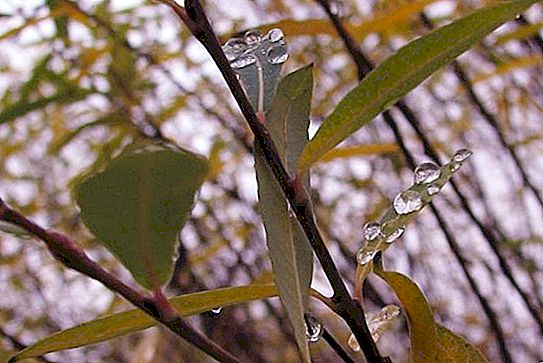Purple willow is an elegant shrub that reaches a height of one to ten meters. Its branches are thin, flexible and smooth, have a bluish coating. They are covered with bark, which has a reddish yellow, yellow or purple hue on the outside and lemon yellow on the inside. Their wood is white, not losing its shade. It is used as a vine for weaving elegant baskets.
In nature, purple willow is often found in moist meadows, along the banks of ponds, rivers and ravines. It is easily propagated by cuttings, tolerates severe frosts. Life expectancy is limited to thirty years. In the villages hedges are planted from it, planted to strengthen the shores on ponds. Willow purple spherical is used for decorative purposes for landscaping. Due to the bitterness of the leaves, the plant is not eaten by cattle.

Purple willow blooms in spring one of the first. Its inflorescences - earrings - are very beautiful, therefore, freshly cut, they are used in bouquets. According to the Orthodox tradition, willow is dedicated to a big holiday a week before Easter. On this Sunday day, its branches are consecrated in temples, and then stored as a talisman in the homes of believers. In the sun and in the shade, in single plantings and in groups, it develops perfectly and creates wonderful compositions in areas with excessive moisture and purple willow in the ponds. The photo attached to this article conveys well the tenderness and grace of this plant thankful to people.

As a medicinal raw material, it is used not only in traditional medicine, but also in homeopathy and pharmacology. For example, homeopaths offer recipes for treating dizziness, loose stools, pain in the hip joint, fevers and swelling parotid glands with the help of leaves and inflorescences of this plant. Scientific medicine believes that the remarkable chemical composition of the bark of this plant allows it to be used to produce anti-inflammatory drugs for the treatment of joint pain. In male inflorescences, biochemical studies have found phenolic glucosides such as salicin and salicortin. One hundred grams of dry raw materials contain up to 0.25% of estrogen, the female sex hormone.

Surprisingly, traditional healers have long used purple willow catkins as therapeutic raw materials to suppress increased sexual excitability in men. With their help, it is possible to alleviate the state of erotomaniacs, to calm a person suffering from insomnia due to erotic arousal. It is recommended to take this medicine in case of oozing.
Raw materials need to be harvested exclusively in early spring during the flowering of purple willow. The collected material must be spread out on canvas or clean paper with a thin layer in a ventilated room and dried well, stirring occasionally.
To prepare the medicine, you need to take one tablespoon of dried inflorescences, pour them with boiling water in a volume of 0.6 liters and, having covered the vessel with a lid, soak for thirty minutes to an hour. Then strain the liquid fraction through two layers of gauze. Give the finished medicine to the patient one glass three times a day. Take in the form of heat for fifteen minutes before eating.




